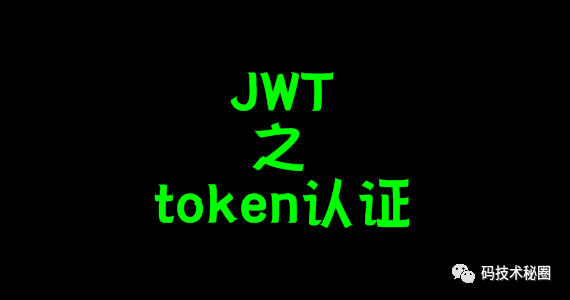
1. Implement the annotation classes that skip authentication (PassToken) and require authentication (UserLoginToken)
@Target({ElementType.METHOD, ElementType.TYPE})
@Retention(RetentionPolicy.RUNTIME)
public @interface PassToken {
boolean required() default true;
}@Target({ElementType.METHOD, ElementType.TYPE})
@Retention(RetentionPolicy.RUNTIME)
public @interface UserLoginToken {
boolean required() default true;
}2. Implement getting Token class (TokenService)
@Service
public class TokenService {
public String getToken(User user) {
// Expiration time, 5 minutes
long EXPIRE_TIME = 5*60*1000;
// Build expiration
Date expireDate = new Date(System.currentTimeMillis()+EXPIRE_TIME);
String token = JWT.create().withAudience(user.getId())// Save user id to token
.withExpiresAt(expireDate)// Set expiration time
.sign(Algorithm.HMAC256(user.getPassword()));// password as the key of token
return token;
}
}3. Implement the token authentication class (AuthenticationInterceptor)
public class AuthenticationInterceptor implements HandlerInterceptor {
@Autowired
UserService userService;
@Override
public boolean preHandle(HttpServletRequest httpServletRequest, HttpServletResponse httpServletResponse, Object object) throws Exception {
String token = httpServletRequest.getHeader("token");// Take token from http request header
// If it is not mapped to a method directly through
if(!(object instanceof HandlerMethod)){
return true;
}
HandlerMethod handlerMethod=(HandlerMethod)object;
Method method=handlerMethod.getMethod();
//Check whether there is a passtoken comment, and skip authentication if there is one
if (method.isAnnotationPresent(PassToken.class)) {
PassToken passToken = method.getAnnotation(PassToken.class);
if (passToken.required()) {
return true;
}
}
//Check for comments that require user rights
if (method.isAnnotationPresent(UserLoginToken.class)) {
UserLoginToken userLoginToken = method.getAnnotation(UserLoginToken.class);
if (userLoginToken.required()) {
// Executive certification
if (token == null) {
throw new RuntimeException("Not signed in, please sign in");
}
// Get user id in token
String userId;
try {
userId = JWT.decode(token).getAudience().get(0);
} catch (JWTDecodeException j) {
throw new RuntimeException("token Wrong authentication name, please login again");
}
User user = userService.findUserById(userId);
if (user == null) {
throw new RuntimeException("User does not exist, please login again");
}
// Verify token
JWTVerifier jwtVerifier = JWT.require(Algorithm.HMAC256(user.getPassword())).build();
try {
jwtVerifier.verify(token);
} catch (JWTVerificationException e) {
throw new RuntimeException("token The authentication password is wrong or the login has expired. Please login again");
}
return true;
}
}
return true;
}
@Override
public void postHandle(HttpServletRequest httpServletRequest,
HttpServletResponse httpServletResponse,
Object o, ModelAndView modelAndView) throws Exception {
}
@Override
public void afterCompletion(HttpServletRequest httpServletRequest,
HttpServletResponse httpServletResponse,
Object o, Exception e) throws Exception {
}
}4. Because you need to throw an exception, implement a global exception capture class ()
@ControllerAdvice
public class GloablExceptionHandler {
@ResponseBody
@ExceptionHandler(Exception.class)
public Object handleException(Exception e) {
String msg = e.getMessage();
if (msg == null || msg.equals("")) {
msg = "Server error";
}
JSONObject jsonObject = new JSONObject();
jsonObject.put("status", 500);
jsonObject.put("message", msg);
return jsonObject;
}
}5. Add the InterceptorConfig to verify all the mapping paths
@Configuration
public class InterceptorConfig implements WebMvcConfigurer {
@Override
public void addInterceptors(InterceptorRegistry registry) {
registry.addInterceptor(authenticationInterceptor())
.addPathPatterns("/**"); // Block all requests, and determine whether to log in by judging whether there is @ UserLoginToken annotation
}
@Bean
public AuthenticationInterceptor authenticationInterceptor() {
return new AuthenticationInterceptor();
}
}6. Implement access class (UserController)
@RestController
@RequestMapping("/api")
public class UserController {
@Autowired
UserService userService;
@Autowired
TokenService tokenService;
//Sign in
@PostMapping("/login")
public Object login(@RequestBody User user){
JSONObject jsonObject=new JSONObject();
User userForBase=userService.findUserById("user");
if(userForBase==null){
jsonObject.put("message","Login failed,user does not exist");
return jsonObject;
}else {
if (!userForBase.getPassword().equals(user.getPassword())){
jsonObject.put("message","Login failed,Password error");
return jsonObject;
}else {
String token = tokenService.getToken(userForBase);
jsonObject.put("token", token);
jsonObject.put("user", userForBase);
return jsonObject;
}
}
}
@UserLoginToken
@GetMapping("/getMessage")
public Object getMessage(){
Map<String, Object> retMap = new HashMap<>();
retMap.put("message", "You have passed the verification");
retMap.put("status", 200);
return retMap;
}
}7. Post man access
* http://127.0.0.1:8080/api/login
* http://127.0.0.1:8080/api/getMessage
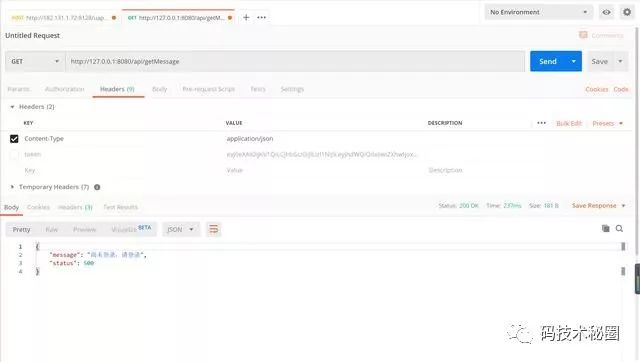
No access effect before login
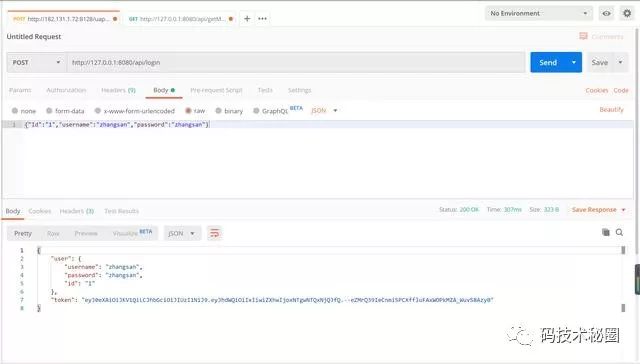
Login successfully
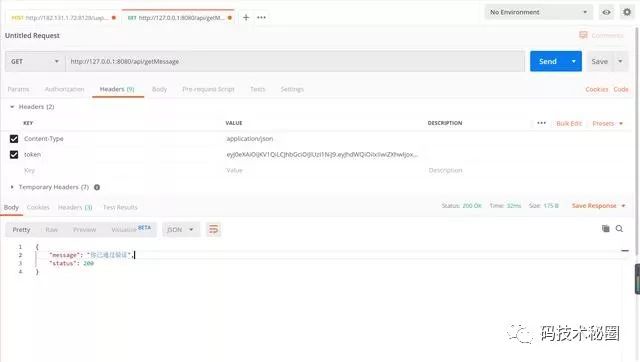
Login succeeded with token access
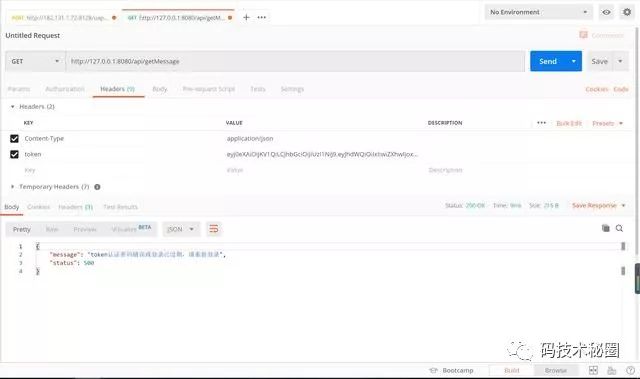
Access after token error or login time expires
Source code address of github project
https://github.com/kenyonlover/spring_boot_jwt_test
Published 11 original articles, praised 0, visited 1645

